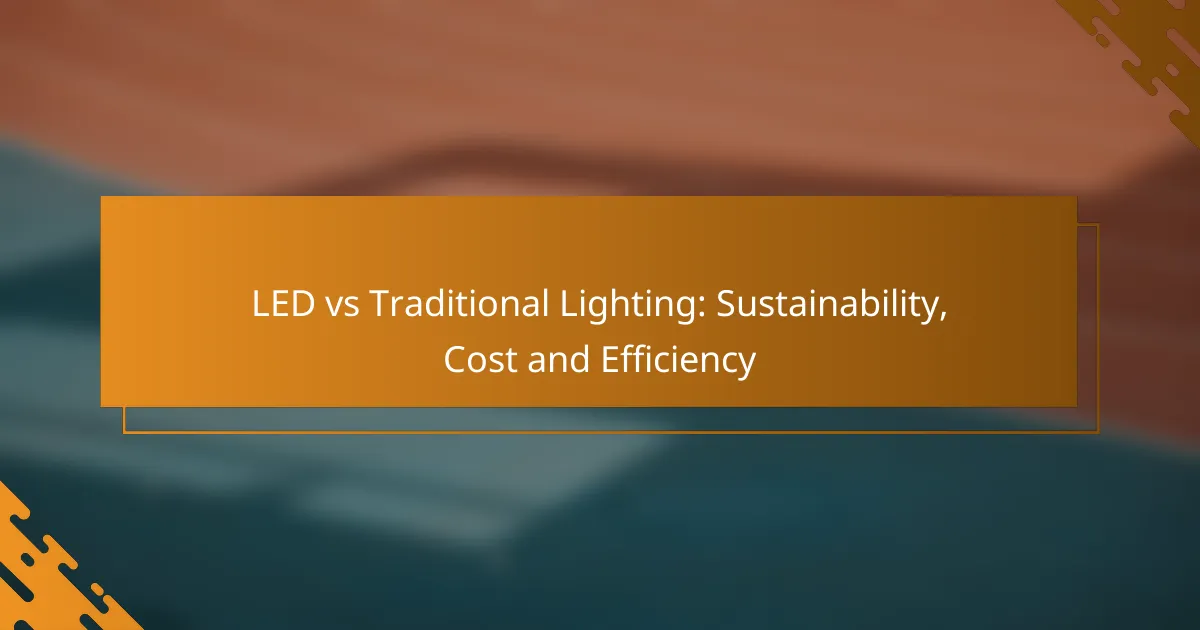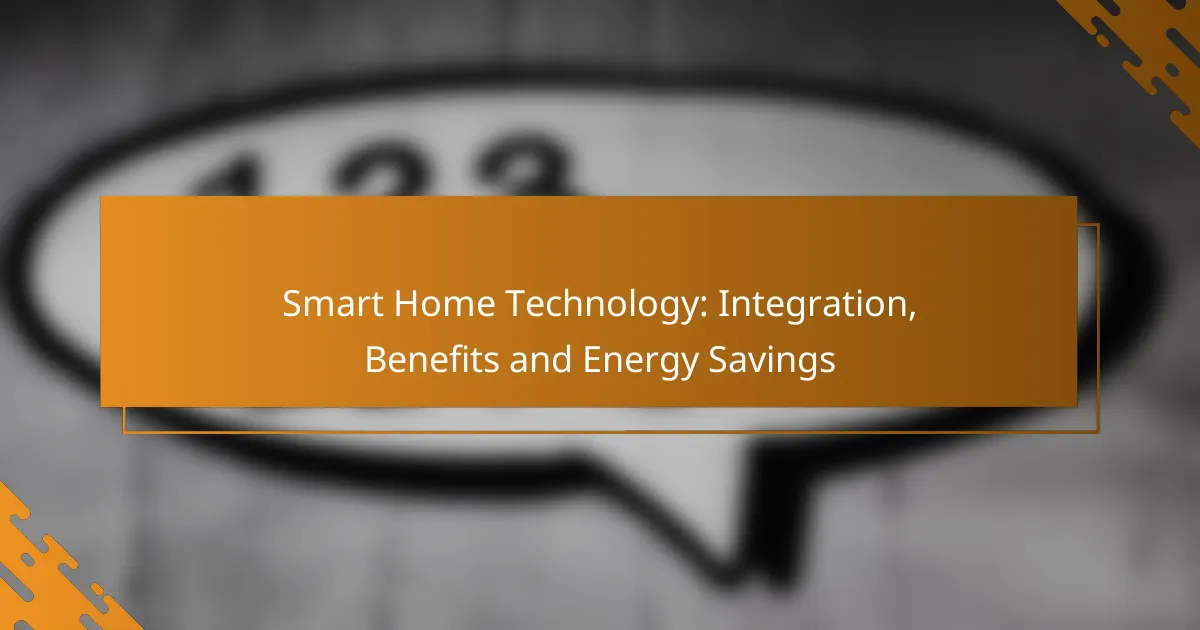As the world increasingly prioritizes sustainability, the comparison between LED and traditional lighting becomes crucial. LED lighting not only boasts a longer lifespan and lower energy consumption but also offers significant cost savings in the long run. While the initial investment may be higher, the efficiency and reduced environmental impact of LEDs make them a compelling choice for both consumers and businesses alike.

How does LED lighting compare to traditional lighting in sustainability?
LED lighting is generally more sustainable than traditional lighting options, such as incandescent or fluorescent bulbs. This sustainability is evident in several key areas, including carbon footprint, lifespan, and energy consumption.
Lower carbon footprint
LED lights produce significantly less carbon dioxide compared to traditional lighting. This reduction is primarily due to their higher efficiency, which means they require less energy to produce the same amount of light. For instance, switching to LED lighting can lead to a decrease in greenhouse gas emissions by tens of percent over time.
Additionally, many countries are implementing regulations to phase out less efficient lighting, further encouraging the adoption of LEDs. This shift not only helps reduce individual carbon footprints but also contributes to national and global sustainability goals.
Longer lifespan
LED lights have a much longer lifespan than traditional bulbs, often lasting up to 25,000 hours or more. In contrast, incandescent bulbs typically last around 1,000 hours, and fluorescent lights about 7,000 to 15,000 hours. This longevity means fewer replacements and less waste, making LEDs a more sustainable choice.
Choosing LED lighting can significantly reduce the frequency of bulb changes, which is beneficial for both residential and commercial settings. This extended lifespan also translates to lower maintenance costs and less environmental impact from manufacturing and disposing of bulbs.
Reduced energy consumption
LED lighting consumes substantially less energy than traditional lighting options. While an incandescent bulb may use around 60 watts to produce a similar light output as a 10-watt LED, the energy savings can be significant over time. This efficiency translates to lower electricity bills and reduced demand on power plants.
In many regions, using LED lights can lead to energy savings of 50-80%, depending on usage patterns. These savings not only benefit consumers financially but also contribute to a decrease in overall energy consumption, supporting broader sustainability efforts.
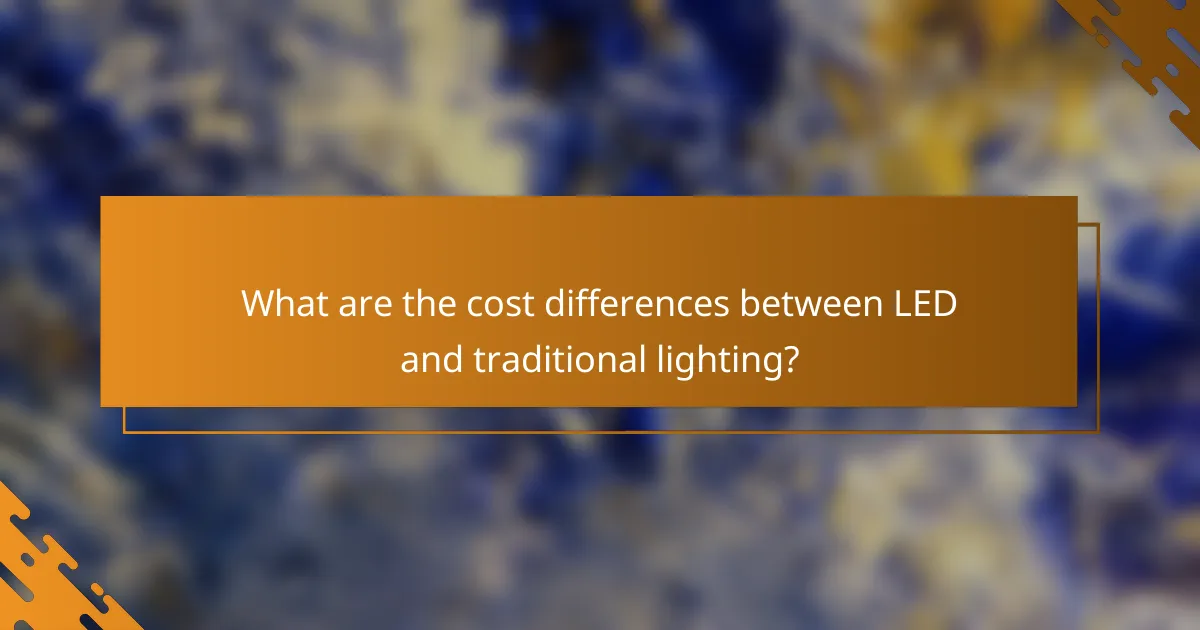
What are the cost differences between LED and traditional lighting?
The cost differences between LED and traditional lighting primarily revolve around initial purchase price, long-term savings, and maintenance costs. While LEDs may have a higher upfront cost, they often lead to significant savings over time due to their efficiency and longevity.
Initial purchase price
The initial purchase price of traditional lighting, such as incandescent or fluorescent bulbs, is generally lower than that of LED bulbs. Incandescent bulbs can cost just a few dollars each, while LED bulbs may range from several dollars to over twenty dollars, depending on the brand and features. However, the price gap is narrowing as LED technology becomes more widespread.
Long-term savings
Long-term savings with LED lighting can be substantial. LEDs consume significantly less energy than traditional bulbs, often reducing electricity costs by up to 75%. Additionally, their lifespan can exceed 25,000 hours compared to the 1,000 hours typical of incandescent bulbs, resulting in fewer replacements and lower overall energy bills.
Maintenance costs
Maintenance costs for traditional lighting can be higher due to the need for frequent replacements and the labor involved in changing bulbs, especially in commercial settings. In contrast, LEDs require less maintenance because of their durability and longer lifespan. This reduced frequency of replacement can lead to lower labor costs and less waste, contributing to overall sustainability.
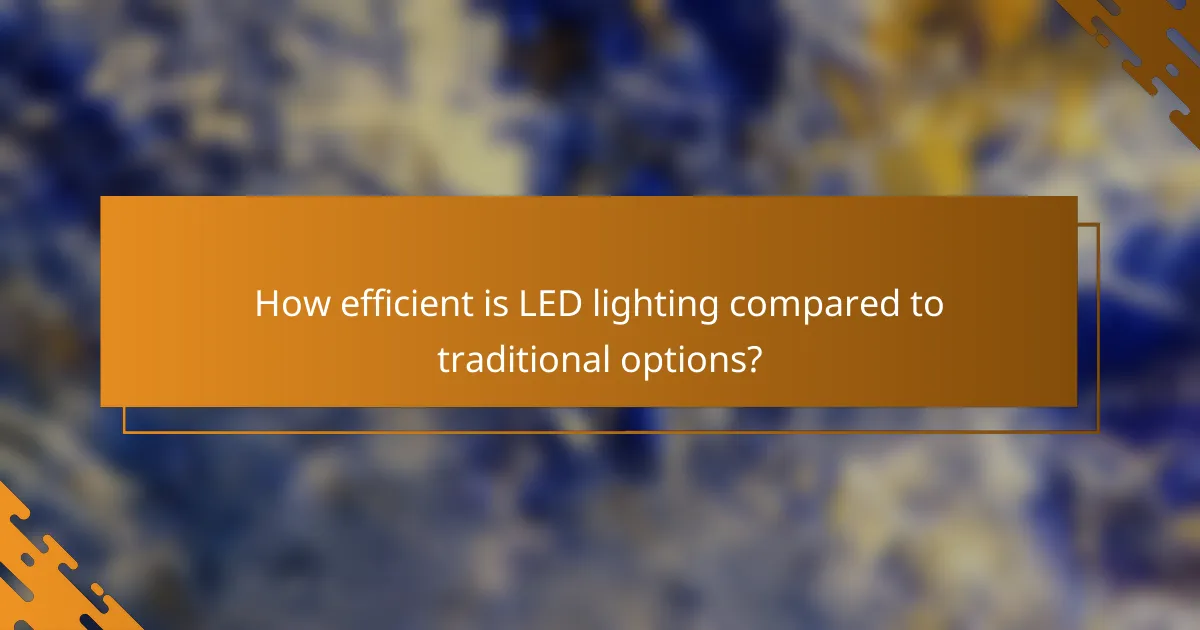
How efficient is LED lighting compared to traditional options?
LED lighting is significantly more efficient than traditional lighting options, consuming less energy while providing the same or greater light output. This efficiency translates into lower electricity bills and reduced environmental impact over time.
Higher luminous efficacy
LED lights typically have a luminous efficacy ranging from 80 to 100 lumens per watt, while traditional incandescent bulbs usually offer around 10 to 17 lumens per watt. This means LEDs produce much more light for each watt of electricity consumed, making them a more sustainable choice for illumination.
When selecting lighting for a space, consider the luminous efficacy to determine the most energy-efficient option. Higher efficacy not only saves energy but also reduces the frequency of bulb replacements, further enhancing sustainability.
Instant brightness
LED lights reach full brightness almost instantly, unlike traditional fluorescent or incandescent bulbs that may take time to warm up. This immediate illumination is particularly beneficial in settings where instant light is crucial, such as in emergency lighting or outdoor security applications.
Choosing LED fixtures can enhance user experience by eliminating the wait time associated with other lighting types. This feature is especially valuable in commercial spaces where efficiency and responsiveness are essential.
Heat generation
LED lighting generates significantly less heat compared to traditional options, which can waste energy through heat dissipation. While incandescent bulbs convert about 90% of their energy into heat, LEDs convert most of their energy into light, making them safer and more efficient.
Lower heat generation not only contributes to energy savings but also reduces cooling costs in warmer climates. This aspect is crucial for both residential and commercial buildings aiming to maintain energy efficiency and comfort.

What are the environmental impacts of traditional lighting?
Traditional lighting, particularly incandescent and fluorescent bulbs, has significant environmental impacts, primarily due to their energy consumption and hazardous materials. These lighting options contribute to higher greenhouse gas emissions and pose disposal challenges due to toxic components.
Mercury content in bulbs
Fluorescent bulbs contain mercury, a toxic heavy metal that can cause serious health and environmental issues if not handled properly. Even small amounts of mercury can contaminate water supplies, leading to bioaccumulation in fish and other wildlife.
When disposing of fluorescent bulbs, it is crucial to follow local regulations regarding hazardous waste. Many areas require these bulbs to be recycled at designated facilities to prevent mercury from entering landfills.
Waste disposal issues
Traditional lighting options often contribute to significant waste, as many bulbs are not recyclable and end up in landfills. This can lead to the leaching of harmful substances into the soil and groundwater, creating long-term environmental hazards.
To mitigate waste disposal issues, consumers should seek out recycling programs for their used bulbs. Many retailers offer take-back programs, allowing for safe disposal and minimizing environmental impact.

What factors should I consider when choosing lighting for my home?
When selecting lighting for your home, consider room size, energy efficiency, and compatibility with smart systems. These factors will help you create a well-lit environment that meets your needs while being cost-effective and sustainable.
Room size and purpose
The size and purpose of a room significantly influence the type of lighting you should choose. Larger rooms may require multiple light sources or fixtures to ensure even illumination, while smaller spaces might be adequately lit with a single overhead light. For example, a living room may benefit from ambient lighting combined with task lighting for reading areas.
Consider the activities that will take place in each room. Kitchens and workspaces often need brighter, focused lighting, while bedrooms may benefit from softer, warmer tones to create a relaxing atmosphere. Aim for a balance that enhances functionality without overwhelming the space.
Energy efficiency ratings
Energy efficiency ratings are crucial when selecting lighting, as they indicate how much energy a fixture consumes compared to the light it produces. Look for LED lights with high efficiency ratings, which can use up to 75% less energy than traditional incandescent bulbs. This not only reduces your electricity bills but also minimizes your environmental impact.
Familiarize yourself with labels such as ENERGY STAR, which signifies that a product meets strict efficiency guidelines. Additionally, consider the lifespan of the bulbs; LEDs typically last tens of thousands of hours, making them a more sustainable choice over time.
Compatibility with smart systems
Choosing lighting that is compatible with smart home systems can enhance convenience and energy management. Smart bulbs and fixtures allow you to control lighting remotely, set schedules, and adjust brightness levels through apps or voice commands. This capability can lead to significant energy savings and improved comfort.
When selecting smart lighting, ensure it integrates seamlessly with your existing smart home ecosystem, such as Google Home or Amazon Alexa. Look for products that offer easy installation and user-friendly interfaces to maximize their benefits without complicating your setup.
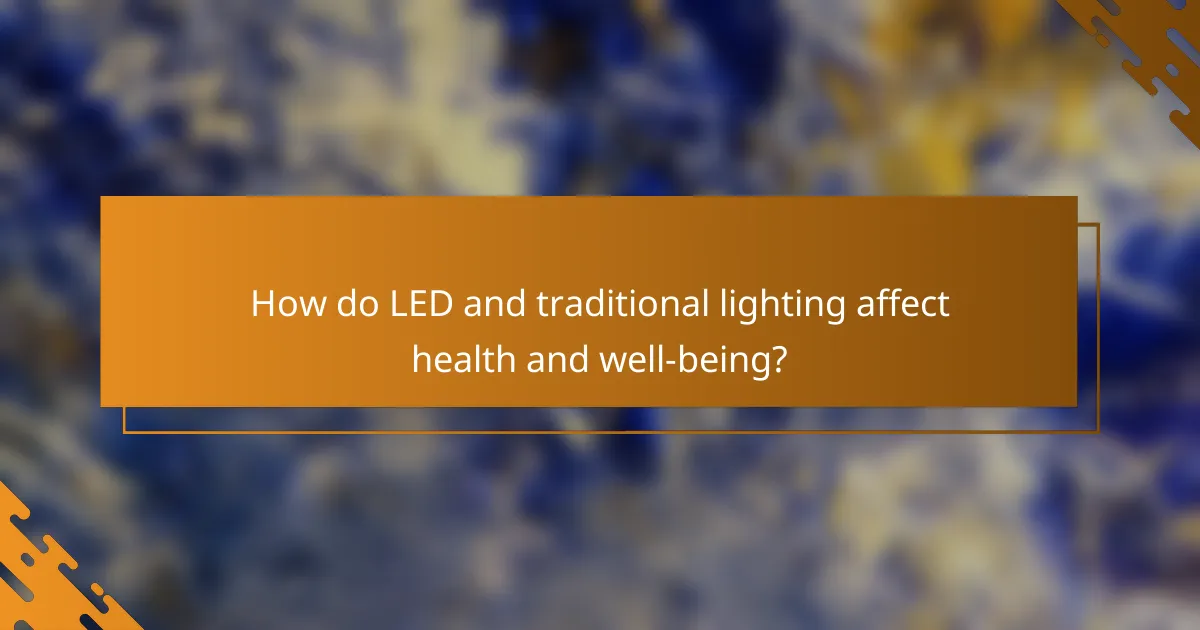
How do LED and traditional lighting affect health and well-being?
LED and traditional lighting can significantly impact health and well-being through factors like blue light exposure and circadian rhythms. Understanding these effects helps in making informed choices about lighting in homes and workplaces.
Blue light exposure
Blue light exposure from LED lighting can disrupt sleep patterns and affect overall health. LEDs emit a higher percentage of blue light compared to traditional incandescent bulbs, which can interfere with melatonin production, making it harder to fall asleep.
To mitigate the negative effects of blue light, consider using warmer LED bulbs in the evening. Look for bulbs with a color temperature below 3000K, which emit less blue light and are more conducive to relaxation and sleep.
